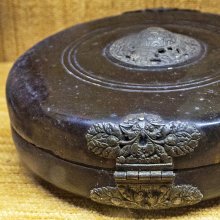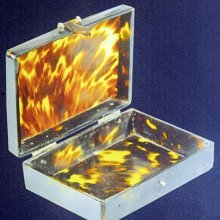Abharana, Ābharaṇa: 32 definitions
Introduction:
Abharana means something in Buddhism, Pali, Hinduism, Sanskrit, Marathi, Jainism, Prakrit, Hindi. If you want to know the exact meaning, history, etymology or English translation of this term then check out the descriptions on this page. Add your comment or reference to a book if you want to contribute to this summary article.
Alternative spellings of this word include Abharan.
Images (photo gallery)
(+12 more images available)
In Hinduism
Natyashastra (theatrics and dramaturgy)
Source: Wisdom Library: Nāṭya-śāstraĀbharaṇa (आभरण) refers to “ornaments” and is one of the four types of alaṃkāra, or “decorations”, according to Nāṭyaśāstra chapter 23. Alaṃkāra represents one of the categories of nepathya, or “costumes and make-up”, the perfection of which forms the main concern of the Āhāryābhinaya, or “extraneous representation”, a critical component for a successful dramatic play.
There are five types of ornaments (ābharaṇa):
- āvedhya (that to be fixed by piercing the limbs),
- bandhanīya (that to be tied up),
- prakṣepya (that to be worn),
- āropya (that to be put round).

Natyashastra (नाट्यशास्त्र, nāṭyaśāstra) refers to both the ancient Indian tradition (shastra) of performing arts, (natya—theatrics, drama, dance, music), as well as the name of a Sanskrit work dealing with these subjects. It also teaches the rules for composing Dramatic plays (nataka), construction and performance of Theater, and Poetic works (kavya).
Shaivism (Shaiva philosophy)
Source: Google Books: Manthanabhairavatantram (shaivism)Ābharaṇa (आभरण) refers to “ornaments”, according to the Śrīmatottara-tantra, an expansion of the Kubjikāmatatantra: the earliest popular and most authoritative Tantra of the Kubjikā cult. Accordingly, “O goddess, Svacchanda is in the middle, within the abode of the triangle. Very powerful, he has five faces with three times five flaming eyes. He has ten arms and, very fierce, is adorned with many garlands, ornaments [i.e., nānā-ābharaṇa-saṃyukta], necklaces and anklets. He has beautiful matted hair and the half moon is his crest jewel. O beloved, the face in the east is white like cow’s milk, it shines brilliant white. Generating great energy, contemplate it thus. One should think that the northern face is like the young rising sun, the form of a pomegranate flower and (red) like a Bandhūka”.
Source: Shodhganga: Temple management in the ĀgamasĀbharaṇa (आभरण) refers to “ornaments” and represents one of the various upacāras (offerings), in pūjā (ritual worship), as defined in the Śaivāgamas.—Pūjā consists of offering hospitality, in the form of water to wash the feet, to drink, water for ablutions, offering a bath, new clothes, fragrant unguents, fragrant flowers and ornaments, food and so on. Each step in the pūjā process is called “saṃskāra” and each offering is called “upacāra” [viz., Ābharaṇa].
Source: Brill: Śaivism and the Tantric Traditions1) Ābharaṇa (आभरण) refers to “ornaments”, according to the 9th-century Sarvajñānottaratantra chapter 18.—Accordingly, “Next, I shall teach the best observance among observances, which is known as the Śiva-vrata and which is revered by Asuras and Gods alike. Pure pale ash [should be used, and] white dress and unguents; he should wear a white sacred thread and be adorned by a chignon of matted locks. He should be equipped with all [suitable] ornaments (sarva-ābharaṇa-sampanna), [and] adorned with white garlands; he should consume [only the pure ritual gruel-offering known as] caru; he should observe the chaste conduct of a student; he should venerate Śiva, the fire and his Guru. [...]”.
2) Ābharaṇa (आभरण) refers to the “ornaments” (of one’s Guru) , according to the 13th-century Matsyendrasaṃhitā: a Kubjikā-Tripurā oriented Tantric Yoga text of the Ṣaḍanvayaśāmbhava tradition from South India.—Accordingly, “After this, O Śivā, hear the exposition of the Kula Conduct. After he has joined the tradition of the Siddhas, he should worship his guru as divine. The Yogin who is engaged in the worship of his guru can obtain the highest Power. The guru’s bedstead, his bedding, clothes, ornaments (ābharaṇa), sandals, parasol, antilope-skin, bowl or anything else: if he touches any of these with his feet, he should place them on his head and recite [mantras] eight times. [...]”.
Source: SOAS University of London: Protective Rites in the Netra TantraĀbharaṇa (आभरण) refers to “(being) decorated” (with a cron), according to the Netratantra of Kṣemarāja: a Śaiva text from the 9th century in which Śiva (Bhairava) teaches Pārvatī topics such as metaphysics, cosmology, and soteriology.—Accordingly, [verse 2.17-19]—“The pure-souled Ācārya should draw an eight petaled lotus, in smooth, pure earth [that is] smeared with sandal and aloe wood [and] scented [with] fragrant camphor and strong saffron. After he has drawn [the lotus] with a great undertaking, [the Ācarya,] decorated (ābharaṇa) and adorned with a crown, smeared with sandalwood, [writes] the mātṛkā. Having placed oṃ in the middle [on the pericarp of the lotus], he should draw [the phonemes of the mātṛkā on the petals] starting in the East”.

Shaiva (शैव, śaiva) or Shaivism (śaivism) represents a tradition of Hinduism worshiping Shiva as the supreme being. Closely related to Shaktism, Shaiva literature includes a range of scriptures, including Tantras, while the root of this tradition may be traced back to the ancient Vedas.
Purana and Itihasa (epic history)
Source: archive.org: Shiva Purana - English TranslationĀbharaṇa (आभरण) refers to “beautiful ornaments”, mentioned as one of the potential rewards of Śiva-worship, according to the Śivapurāṇa 2.1.12:—“[...] those who desire magnificent buildings, beautiful ornaments (ābharaṇa), beautiful women, wealth to satiety, sons and grandsons, health, splendid body, extraordinary status, heavenly happiness and final salvation or profound devotion to the great lord shall duly worship Śiva by virtue of their merit accumulated by them. Sure success will be his who regularly worships Śiva liṅga with great devotion. He will never be afflicted by sins”.
Ābharaṇa refers to the body being “decorated with ornaments”, according to the Śivapurāṇa 2.2.21. Accordingly as Brahmā narrated to Nārada:—“[...] When they [viz., Śiva’s Gaṇas (attendants)] went away and He was left alone with Satī, Śiva rejoiced much and sported with her. [...] Sometimes he would gather lotuses (padmapuṣpa) and other beautiful flowers (ramyapuṣpa) and decorate her with them as though with ornaments (ābharaṇa)”.
Ābharaṇa (“ornaments”) forms part of the royal paraphernalia (mahārājopacāra), according to the Śivapurāṇa 2.2.28. Accordingly as Brahmā narrated to Nārada:—“[...] Lord Śiva, possessed of the perfect vision, realising everything and seeing all, and the cause of protection, being requested by the Goddess, spoke to her:—‘[...] You can go in royal splendour mounting this bull richly caparisoned’. Satī thus commanded to mount the decorated bull, bedecked herself and started for her father’s abode. The royal paraphernalia (mahārājopacāra) like the umbrella, chowries, silken clothes and ornaments (ābharaṇa) were given to her by (Śiva) the great lord”.
Source: valmikiramayan.net: Srimad Valmiki RamayanaĀbharaṇa (आभरण) refers to “ornaments”, according to the Rāmāyaṇa verse 5.3.8-13. Accordingly:—“[...] Seeing the city [viz., Laṅkā] everywhere Hanuma (Hanumān) became surprised at heart. Thereafter Hanuma the monkey, became happy seeing [...] auspicious houses resounding everywhere with the sounds of clarionets (tūrya) and ornaments (ābharaṇa), [...], equalling the city of Vasvaukasārā, as though flying towards the sky. Seeing that city of Rāvaṇa, which was best among cities, a wealthy city, a beautiful and auspicious city, that powerful Hanuma thought thus”.

The Purana (पुराण, purāṇas) refers to Sanskrit literature preserving ancient India’s vast cultural history, including historical legends, religious ceremonies, various arts and sciences. The eighteen mahapuranas total over 400,000 shlokas (metrical couplets) and date to at least several centuries BCE.
Shilpashastra (iconography)
Source: Shodhganga: Vaisnava Agamas And Visnu ImagesĀbharaṇa (आभरण) refers to “ornaments”, as defined in treatises such as the Pāñcarātra, Pādmasaṃhitā and Vaikhānasa-āgamas, extensively dealing with the technical features of temple art, iconography and architecture in Vaishnavism.—The embellishments or accessories, known by the collective name of Ābharaṇa, not only serve the purpose of adding aesthetic value to the icon, but also are indeed meant to express the status or degree of the particular deity in relation to the other forms. The ornaments highlight the essential nature, attitude and qualities embodied by the same.
It is mentioned in the Vāstusūtra-upaniṣad (p. 102), “By ornamentation (tadbhūṣaṇāt) an attractive sight is obtained... By seeing these ornaments all people rejoice... From delight grows contemplation, from understanding the icon, the realization of Brahman, which is bliss, thus it is said in the Veda...”. Bharata, the earliest to detail the ornaments, states that an improper dress will not enhance the beauty but becomes ridicules like the girdle placed on the breast.

Shilpashastra (शिल्पशास्त्र, śilpaśāstra) represents the ancient Indian science (shastra) of creative arts (shilpa) such as sculpture, iconography and painting. Closely related to Vastushastra (architecture), they often share the same literature.
Shaktism (Shakta philosophy)
Source: Google Books: ManthanabhairavatantramĀbharaṇa (आभरण) refers to “ornaments”, according to the Śrīmatottara-tantra, an expansion of the Kubjikāmatatantra: the earliest popular and most authoritative Tantra of the Kubjikā cult.—Accordingly, “He who has the vidyā within (his) body by recollecting (it) attracts (towards himself) with the vidyā the supreme goal (of life), the best of women (parastrī) endowed with divine ornaments [i.e., divya-ābharaṇa-saṃyutā], the supreme nature, good fortune, the supreme scripture, the supreme Command, the supreme knowledge, and the alchemical mercury”.

Shakta (शाक्त, śākta) or Shaktism (śāktism) represents a tradition of Hinduism where the Goddess (Devi) is revered and worshipped. Shakta literature includes a range of scriptures, including various Agamas and Tantras, although its roots may be traced back to the Vedas.
Pancaratra (worship of Nārāyaṇa)
Source: University of Vienna: Sudarśana's Worship at the Royal Court According to the AhirbudhnyasaṃhitāĀbharaṇa (आभरण) refers to “ornaments”, according to the Ahirbudhnyasaṃhitā, belonging to the Pāñcarātra tradition which deals with theology, rituals, iconography, narrative mythology and others.—Accordingly, “One desirous of a kingdom, one who has been deprived of it or one conquered by [other] rulers, after having paid respect with large masses of wealth to the supreme Guru, the giver of Sudarśana’s Yantra, considering [him] superior to all, should propitiate God Nārāyaṇa—who has large eyes like lotuses, is [of] dark [complexion], clad in a yellow garment, adorned with all ornaments (sarva-ābharaṇa-bhūṣita) and with four arms—following the rules given by the teacher. [...]”.

Pancaratra (पाञ्चरात्र, pāñcarātra) represents a tradition of Hinduism where Narayana is revered and worshipped. Closeley related to Vaishnavism, the Pancaratra literature includes various Agamas and tantras incorporating many Vaishnava philosophies.
In Buddhism
Tibetan Buddhism (Vajrayana or tantric Buddhism)
Source: Brill: Śaivism and the Tantric Traditions (tantric Buddhism)Ābharaṇa (आभरण) refers to the “ornaments” (of a youth), according to the Nāmamantrārthāvalokinī by Vilāsavajra, which is a commentary on the Nāmasaṃgīti.—Accordingly, [while describing Ādibuddha]—“[...] He is tranquil, with the ornaments of a youth (kumāra-ābharaṇa-upeta), in fine clothing, wearing about himself a many coloured garment. He has eight arms, holding at his heart with four hands the Śatasāhasrikāprajñāpāramitā divided into four parts, [and] carrying, in each of the other four hands, a sword of wisdom in the gesture of striking. [All this is to be] put in place [i.e. visualised] via the yoga of the four Buddha-thrones”.
Source: MDPI Books: The Ocean of HeroesĀbharaṇa (आभरण) refers to “ornaments”, according to the 10th-century Ḍākārṇava-tantra: one of the last Tibetan Tantric scriptures belonging to the Buddhist Saṃvara tradition consisting of 51 chapters.—Accordingly, “[...] [The Causal Vajra-holder] is white in color, [has] four faces, [has] three eyes [on each], [has] twelve arms, is devoted to the yoga of union with wisdom (his female consort), and is adorned with youthful ornaments (ābharaṇa). [His four faces are], counterclockwise, white, green, red, and yellow [in color, respectively]. [He has] twisted locks of hair and has a crossed vajra and a crescent moon on the face (head). [...]”.

Tibetan Buddhism includes schools such as Nyingma, Kadampa, Kagyu and Gelug. Their primary canon of literature is divided in two broad categories: The Kangyur, which consists of Buddha’s words, and the Tengyur, which includes commentaries from various sources. Esotericism and tantra techniques (vajrayāna) are collected indepently.
Mahayana (major branch of Buddhism)
Source: Wisdom Library: Maha Prajnaparamita SastraĀbharaṇa (आभरण) refers to an “ornament”, according to the 2nd century Mahāprajñāpāramitāśāstra chapter 46.—Accordingly, “Morality is the root of bliss for all beings. It is like a great treasure bringing pearls and jewels. Morality is a great protector that suppresses fears. It is like a great army that destroys thieves. Morality is an ornament (ābharaṇa) to be worn like a necklace. Morality is a great ship capable of crossing the great ocean of saṃsāra. Morality is a great vehicle capable of transporting heavy jewels to the city of nirvāṇa. [...]”.
Source: De Gruyter: A Buddhist Ritual Manual on AgricultureĀbharaṇa (आभरण) refers to “ornaments” (suitable for worship), according to the Vajratuṇḍasamayakalparāja, an ancient Buddhist ritual manual on agriculture from the 5th-century (or earlier), containing various instructions for the Sangha to provide agriculture-related services to laypeople including rain-making, weather control and crop protection.—Accordingly, [after the Bhagavān entered the assembly of Nāgas], “Then the great Nāga king Samantākāracchatrākaraparikara arose from his seat, arranged his outer robe on one shoulder, placed his right knee on the ground, approached the Bhagavān and, having bowed down at his feet, circumambulated him three times, and worshipped the Bhagavān with different flowers, fragrances, garlands, ointments, ornaments [e.g., nānā-ābharaṇa] and cloths. Having worshipped him, he sat down in front of him”.

Mahayana (महायान, mahāyāna) is a major branch of Buddhism focusing on the path of a Bodhisattva (spiritual aspirants/ enlightened beings). Extant literature is vast and primarely composed in the Sanskrit language. There are many sūtras of which some of the earliest are the various Prajñāpāramitā sūtras.
Languages of India and abroad
Pali-English dictionary
Source: BuddhaSasana: Concise Pali-English Dictionaryābharaṇa : (nt.) ornament; decoration.
Source: Sutta: The Pali Text Society's Pali-English DictionaryĀbharaṇa, (nt.) (Sk. ābharaṇa, ā + bhṛ) that which is taken up or put on, viz. ornament, decoration, trinkets D.II, 104; Vv 802; J.III, 11, 31; DhA.III, 83; VvA.187. (Page 103)

Pali is the language of the Tipiṭaka, which is the sacred canon of Theravāda Buddhism and contains much of the Buddha’s speech. Closeley related to Sanskrit, both languages are used interchangeably between religions.
Marathi-English dictionary
Source: DDSA: The Molesworth Marathi and English Dictionaryābharaṇa (आभरण).—n (S) An ornament, a trinket, a jewel. 2 Ornament, decoration, embellishment.
Source: DDSA: The Aryabhusan school dictionary, Marathi-Englishābharaṇa (आभरण).—n An ornament; decoration.
Marathi is an Indo-European language having over 70 million native speakers people in (predominantly) Maharashtra India. Marathi, like many other Indo-Aryan languages, evolved from early forms of Prakrit, which itself is a subset of Sanskrit, one of the most ancient languages of the world.
Sanskrit dictionary
Source: DDSA: The practical Sanskrit-English dictionaryĀbharaṇa (आभरण).—See under आभृ (ābhṛ).
Derivable forms: ābharaṇam (आभरणम्).
--- OR ---
Ābharaṇa (आभरण).—
1) An ornament, decoration (fig. also); किमित्यपास्याभरणानि यौवने धृतं त्वया वार्द्धकशोभि वल्कलम् (kimityapāsyābharaṇāni yauvane dhṛtaṃ tvayā vārddhakaśobhi valkalam) Kumārasambhava 5.44; प्रशमाभरणं पराक्रमः (praśamābharaṇaṃ parākramaḥ) Kirātārjunīya 2.32. (ābharaṇa occurs in the names of works; e. g. sarasvatīkaṇṭhābharaṇa).
2) The act of nourishing.
Derivable forms: ābharaṇam (आभरणम्).
Source: Cologne Digital Sanskrit Dictionaries: Edgerton Buddhist Hybrid Sanskrit DictionaryĀbharaṇa (आभरण).—ornament, as m. (recorded only as nt. in Sanskrit, Pali, and Prakrit): Saddharmapuṇḍarīka 362.12 (verse) ye (so, or ye hy, all mss.; ed. em. yā) ābharaṇā bhavanti…vicitrarūpāḥ (so all Nepalese mss.; ed. °pā); Lalitavistara 194.17 (verse) sarve ābharaṇā vikīrṇa patitā muhyanti te vāriṇā, and 18 (with mss.) bhartuś cābharaṇā (acc. pl.; with adṛśi 15) savastramuku- ṭāṃ śayyāgatāṃ vyākulāṃ (Lefm. omits the three anus- vāras).
Source: Cologne Digital Sanskrit Dictionaries: Shabda-Sagara Sanskrit-English DictionaryĀbharaṇa (आभरण).—n.
(-ṇaṃ) 1. Ornament decoration, as jewels, &c. 2. Nourishing. E. āṅ before bhṛñ to fill or nourish, lyuṭ aff.
Source: Cologne Digital Sanskrit Dictionaries: Benfey Sanskrit-English DictionaryĀbharaṇa (आभरण).—i. e. ā-bhṛ + ana, n. Ornaments, as jewels, etc., [Rāmāyaṇa] 3, 55, 6.
Source: Cologne Digital Sanskrit Dictionaries: Cappeller Sanskrit-English DictionaryĀbharaṇa (आभरण).—[neuter] ornament, decoration.
Source: Cologne Digital Sanskrit Dictionaries: Aufrecht Catalogus Catalogorum1) Ābharaṇa (आभरण) as mentioned in Aufrecht’s Catalogus Catalogorum:—a grammatical work, often quoted in Mādhavīyadhātuvṛtti.
2) Ābharaṇa (आभरण):—jy. Colebrooke Misc. Essays Ii^2, 284.
Source: Cologne Digital Sanskrit Dictionaries: Monier-Williams Sanskrit-English Dictionary1) Ābharaṇa (आभरण):—[=ā-bharaṇa] [from ā-bhṛ] n. decorating
2) [v.s. ...] ornament, decoration (as jewels etc.), [Manu-smṛti; Śakuntalā; Hitopadeśa etc.]
3) [v.s. ...] Name of several works (especially ifc.)
Source: Cologne Digital Sanskrit Dictionaries: Yates Sanskrit-English DictionaryĀbharaṇa (आभरण):—[ā-bharaṇa] (ṇaṃ) 1. n. Ornament.
Source: DDSA: Paia-sadda-mahannavo; a comprehensive Prakrit Hindi dictionary (S)Ābharaṇa (आभरण) in the Sanskrit language is related to the Prakrit words: Ābharaṇa, Āharaṇa.
[Sanskrit to German]
Sanskrit, also spelled संस्कृतम् (saṃskṛtam), is an ancient language of India commonly seen as the grandmother of the Indo-European language family (even English!). Closely allied with Prakrit and Pali, Sanskrit is more exhaustive in both grammar and terms and has the most extensive collection of literature in the world, greatly surpassing its sister-languages Greek and Latin.
Hindi dictionary
Source: DDSA: A practical Hindi-English dictionaryĀbharaṇa (आभरण) [Also spelled abharan]:—(nm) ornament; decoration.
...
Prakrit-English dictionary
Source: DDSA: Paia-sadda-mahannavo; a comprehensive Prakrit Hindi dictionaryĀbharaṇa (आभरण) in the Prakrit language is related to the Sanskrit word: Ābharaṇa.
Prakrit is an ancient language closely associated with both Pali and Sanskrit. Jain literature is often composed in this language or sub-dialects, such as the Agamas and their commentaries which are written in Ardhamagadhi and Maharashtri Prakrit. The earliest extant texts can be dated to as early as the 4th century BCE although core portions might be older.
Kannada-English dictionary
Source: Alar: Kannada-English corpusĀbharaṇa (ಆಭರಣ):—
1) [noun] the act of bearing; a putting on.
2) [noun] anything used to add grace or beauty; anything serving to adorn; decoration; embellishment; an ornament.
3) [noun] a desirable or needed adjunct; an ornament.
4) [noun] (fig.) a person whose character or talent adds lustre to the surroundings, society, etc.
Kannada is a Dravidian language (as opposed to the Indo-European language family) mainly spoken in the southwestern region of India.
See also (Relevant definitions)
Starts with: Abharanabhushita, Abharanachattranirghosha, Abharanachhattranirghosha, Abharanakrit, Abharanamandita, Abharanapushkarini, Abharanasamyukta, Abharanasthana, Abharanavibhushita, Abharanayukta, Abharanopeta.
Ends with (+106): Ahastabharana, Amuktabharana, Angabharana, Angushthabharana, Anyoktikanthabharana, Autabharana, Bajarabharana, Balabharana, Bhagavadgitalakshabharana, Bhrityabharana, Bhujagabharana, Bijabharana, Bisabharana, Brahmavidyabharana, Cakrabharana, Candrabharana, Caranabharana, Charanabharana, Daivajnakanthabharana, Darabharana.
Full-text (+100): Aharana, Abharanasthana, Hatthabharana, Aparanam, Abharita, Aparanacceppu, Enpaparanan, Pannakaparanam, Adhirukma, Bandhaniya, Vyavalambin, Kantaparan, Brahmavidyabharana, Vanapushpamaya, Maulyabharana, Caranabharana, Kritabharana, Abharan, Karnabharanaka, Jyotirvidabharana.
Relevant text
Search found 14 books and stories containing Abharana, Ābharaṇa, A-bharana, Ā-bharaṇa; (plurals include: Abharanas, Ābharaṇas, bharanas, bharaṇas). You can also click to the full overview containing English textual excerpts. Below are direct links for the most relevant articles:
Chaitanya Bhagavata (by Bhumipati Dāsa)
Verse 3.5.554 < [Chapter 5 - The Pastimes of Nityānanda]
Verse 2.3.188 < [Chapter 3 - The Lord Manifests His Varāha Form in the House of Murāri and Meets with Nityānanda]
Verse 2.26.41 < [Chapter 26 - Descriptions of the Mercy Bestowed on Śuklāmbara and Vijay and the Lord’s Desire to Accept Sannyāsa]
Garga Samhita (English) (by Danavir Goswami)
Verse 1.12.32 < [Chapter 12 - Description of Śrī Nanda’s Festival]
Verse 2.19.15 < [Chapter 19 - The Rāsa-dance Pastime]
Brihad Bhagavatamrita (commentary) (by Śrī Śrīmad Bhaktivedānta Nārāyana Gosvāmī Mahārāja)
Verse 2.4.68 < [Chapter 4 - Vaikuṇṭha (the spiritual world)]
Shiva Gita (study and summary) (by K. V. Anantharaman)
Puranic encyclopaedia (by Vettam Mani)
Sahitya-kaumudi by Baladeva Vidyabhushana (by Gaurapada Dāsa)
Text 10.75 < [Chapter 10 - Ornaments of Meaning]
Text 6.2 < [Chapter 6 - Third-rate Poetry and Super-excellent Poetry]





